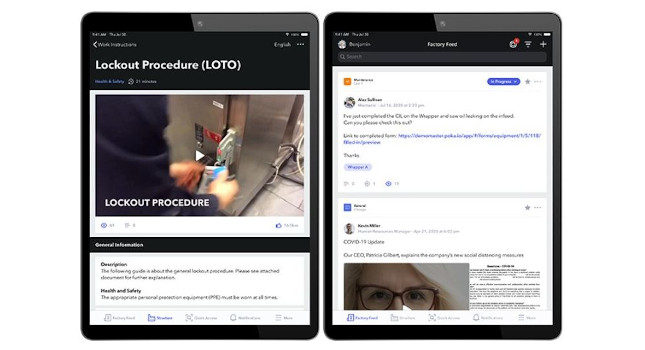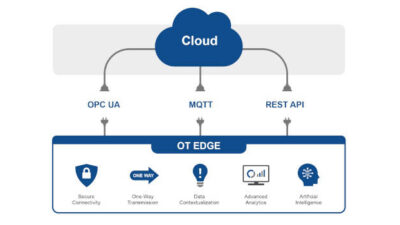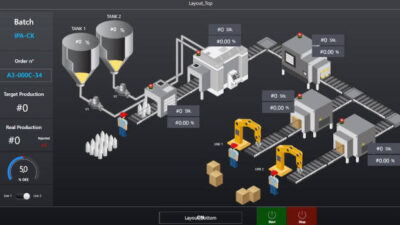Build smarter end-to-end automation systems with edge technologies. See three ways to prepare automation for edge success and case study that resulted in a 5% increase in yield.

An environment that prioritizes worker safety now means an environment where remote capabilities are not only possible, but secure. Enterprises are realizing they need to do more to connect their people and systems, more efficiently, and at a lower cost. To unlock maximum value from operations, automation systems should be end-to-end, meaning they are able to help employees at every stage of the business understand the information critical to them, while offering a holistic overview of operations that allows rapid decisions to be made. Using connected edge solutions, which are automated industrial computing systems that protect and deliver reliable and efficient business critical applications can help provide situational awareness to both upstream and downstream operations. In conjunction, decision-making at appropriate levels of an organization should be empowered by utilizing a decentralized but connected approach with edge devices.
Challenges to edge architectures
Edge devices help offload tasks from machine or process controllers and keep factories or facilities running. However, data from sources like edge devices have historically proven difficult to bring in sight of the supply chain. Traditional barriers to using edge solutions include being able to stay ahead of the technology curve and having access to the full scope of such technologies as and when they become commercially viable and are ready for production.
Moreover, a lack of purpose-built, “off-the-shelf” solutions leads many companies to rely on proprietary software and in-house engineering capabilities to incorporate new technologies. As a result, companies find by using isolated or unconnected systems, they have little context to the greater process; conversely, connected systems are often a one-way data feed with little pull-down insight. An additional challenge is integrating smart systems while accounting for the interoperability required to collect and aggregate data. These challenges limit key system benefits like those that cloud capabilities make possible in terms of key performance indicator-level data democratization, and hamper production transparency from the shop floor to the top floor.
Another challenge posed by edge systems is a large fleet of remote or physical equipment can be very time-consuming to update and maintain. Pushing new application versions or making changes to configurations is often done on an individual or ad-hoc basis, which can result in an edge system acting out of sync.
Such challenges are easier to overcome, thanks to software that provides an edge-to-enterprise solution architecture for complex industrial and infrastructure monitoring and control. A hardware, software, and platform-agnostic approach to interoperability simplifies connectivity between disparate systems and data silos. In total, this makes system integration, maintenance and upgrade far easier to accomplish.
Build smarter edge architectures
Edge devices are used to build smarter end-to-end automation systems. Among the benefits of deploying edge technology are the integrated application development environment, native systems that monitor performance and enable communication across multiple platforms, and remote monitoring and control capabilities, all features that allow for the edge solution to scale and grow with the business.
The integrated development environment that edge offers reduces the time it takes for a company to develop applications. Using built-in capabilities, many edge solutions are then able to deploy applications across multiple platforms, such as industrial computers, laptops, smartphones and tablets or the cloud.
Native drivers also allow seamless communication between human-machine interface (HMI) and supervisory control and data acquisition (SCADA), as well as programmable logic controllers. The tiered architecture of edge also facilitates IIoT-based applications that grows the number of interconnected devices.
For companies’ work environments that are increasingly remote, but still require connected workers and operational excellence, many edge devices have monitoring and control capabilities on smartphones and tablets. Companies can monitor machine status and performance against the Organization for Machine Automation and Control (OMAC) packaging machine language (PackML) data and overall equipment effectiveness (OEE) standards. As a best practice, edge devices should be able to operate independently, but also connect to a larger centralized operations platform for end-to-end visibility.
Optimize factory architecture, machine design, operations
There’s proven business value in the deep visibility into operations that edge provides, speeding up systems maintenance and streamlining compliance efforts.
Some examples of edge devices’ benefits to business include:
- Boosted collaboration: Edge’s unified data platform bridges business silos and delivers real-time, contextual intelligence to everyone. Original equipment manufacturers (OEMs), machine builders, discrete manufacturers, and end users can convert autonomous standalone machines by integrating and exposing machine data to supervisory human-machine interface (HMI) and historical archive systems, thereby providing a broader understanding of the entire operation. No longer isolated, these scattered devices become integral to the overall automation system, even across multiple locations and, in essence, this tool complementing tools across the entire supply chain.
- Increased competitiveness: Engineering productivity gains by deploying edge projects to connected remote nodes from system platforms.
- Reduced costs: Data can be aggregated from the edge to get an eagle-eye view of a plant and then shared across multiple plants, further demonstrating the cost-effectiveness of a portable solution.
- Regulatory compliance: Reports from the edge enable record-keeping, data analysis, regulatory agency compliance, adherence to safety standards, and assist in audits and recalls.
Connecting the edge to the cloud
Connecting an edge device to the cloud helps execute logic at the source to reduce latency and improve speed. The cloud also reduces the total cost of ownership for an edge device and the application lifecycle management by making deployment and conducting maintenance even easier, allowing for configuration updates, version control and remote application monitoring of IIoT devices. IIoT-ready devices can collect data from their sensor and publish to the cloud, which can be leveraged to help give enterprises further visibility into their operations and drive decision making.
In addition, the cloud serves as a powerful tool for helping manage fleets of edge devices. Organizations can look to edge management services within the cloud to help combat the difficulty of remotely updating multiple edge devices at once, ensuring that new applications and updates can be pushed to all machines simultaneously and keep everything working in tandem.
3 ways: Prepare automation for success with edge
Of course, edge solutions are most successful when they meet the goals of the business and don’t overburden users with superfluous information, so it’s important for companies to be able to tailor their edge solution to their business needs.
Companies are looking to connect artificial and human intelligence for better insights and building automation systems that are end-to-end is one of the best ways to achieve this. Edge, which is a great place to start, should be met with the consideration of three tasks:
- Identify the target areas, scope and digital technology and implement them.
- Prepare the workforce to perform the new tasks that deliver value in the optimized plant.
- Execute a plan to implement the business transformation, technology and change management needed for the workforce to scale and realize the gains.
With edge technologies and proper execution companies can reach new heights, heading towards a future with boosted collaboration, increased competitiveness, reduced costs, stronger regulatory compliance and ultimately, a solidified and resilient business.
Case study: Tortilla factory achieves real-time monitoring, reporting
A California-based tortilla factory has grown to be one of the largest and most popular tortilla brands with tortillas distributed nationwide at most major retailers.
The company wanted to implement a shop floor system that would allow it to have real-time data at its fingertips to improve and drive costs down. After evaluating its factory operations, the company found its traditional way of manually doing things was no longer a viable option. A range of disparate systems that previously did not work together had to be able to provide accurate performance data. Moreover, the operations team was unable to successfully achieve day-to-day performance improvements since critical information was not available in real-time and manual reporting was hindering access to key data metrics.
Automation was key to the tortilla factory’s ongoing and future success.
Combining existing factory floor systems into one cohesive view
The tortilla factory implemented a customized solution to easily integrate with and manage the existing equipment and processes. First, the company implemented a system platform that enabled it to build a single, unified plant model that represents processes, physical equipment, industrial systems and even legacy equipment, making the design and maintenance of these systems more flexible and efficient.
An edge solution was used as the system platform’s visualization tool, which provided the factory’s shop floor team real-time visibility into their processes. The edge device also included a more effective HMI design, better troubleshooting, ease of application maintenance, as well as visual enhancements to improve the ability to identify and address abnormal situations before they impacted factory operations.
Results included:
- The tortilla factory achieved a 5% improvement in yield.
- Company-wide visualization of operations data improved teamwork and reaction times.
- Edge software has made the company’s culture of continuous improvement much easier to achieve.
Rashesh Mody is senior vice president and head of monitoring and control, Aveva. Edited by Mark T. Hoske, content manager, Control Engineering, CFE Media and Technology, [email protected].
KEYWORDS: Cloud to edge, digitalization
CONSIDER THIS
Are your automation systems delivering edge to cloud benefits?
Online extra
Learn more about Aveva Teamwork software in the New Products for Engineers database.



